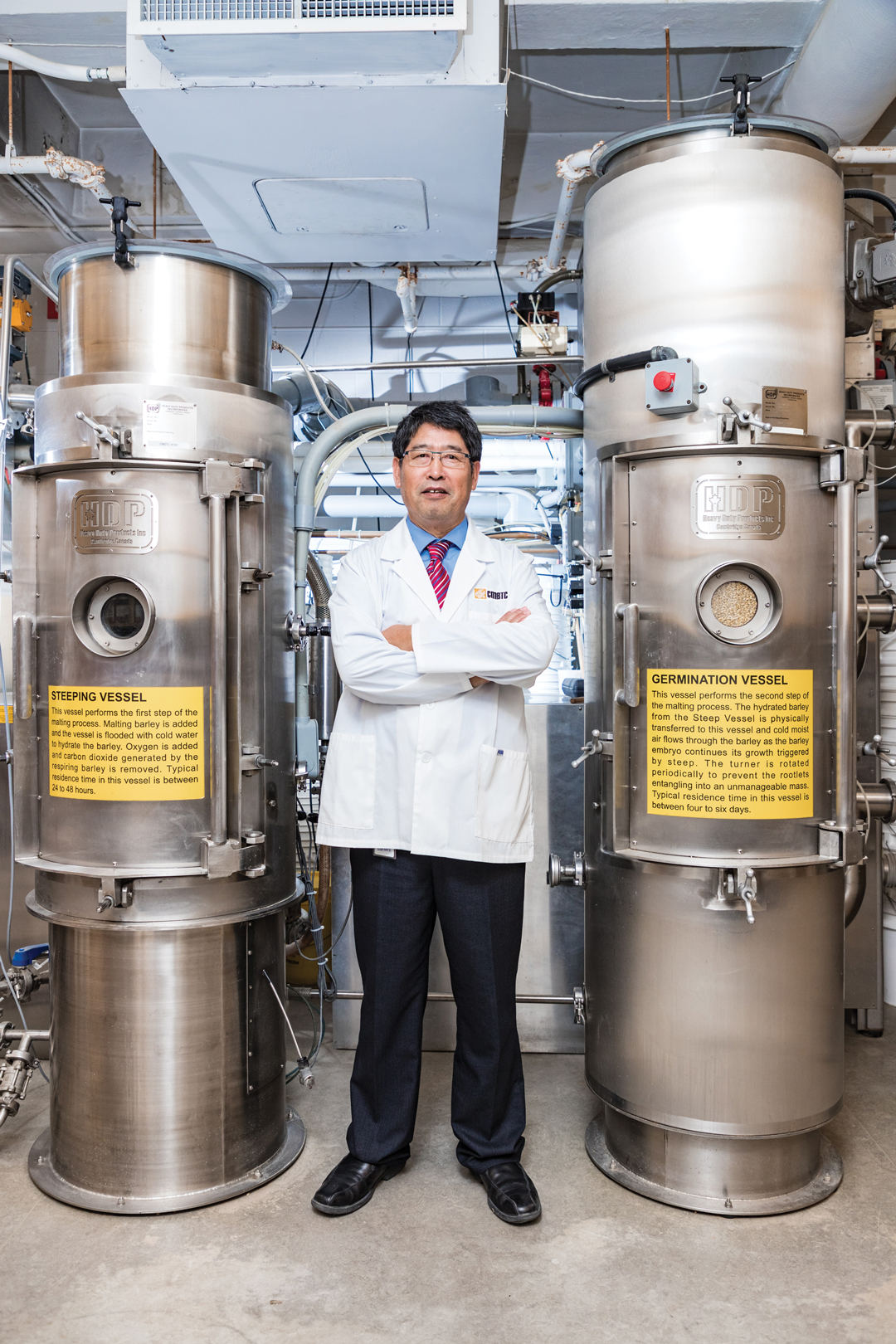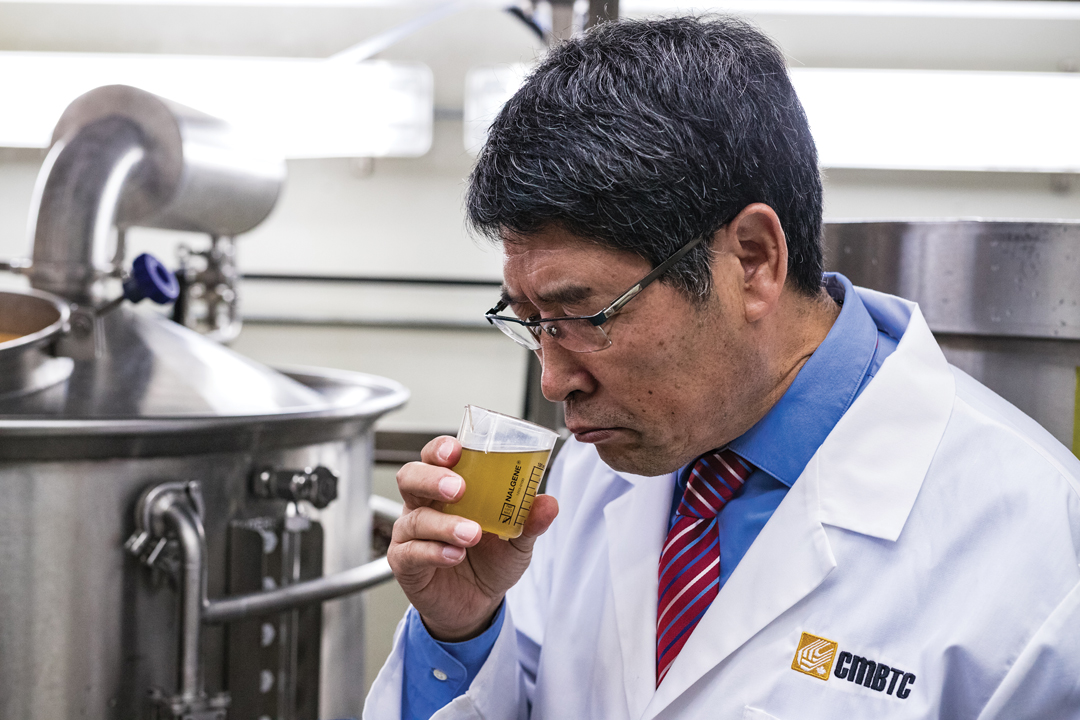A COMMITTED BARLEY BACKER
THE CMBTC’S YUESHU LI IS INVESTED IN THE MALTING INDUSTRY
BY ELLEN COTTEE • PHOTOS BY LEIF NORMAN
Person: Yueshu Li
Place: The Canadian Malting Barley Technical Centre in Winnipeg, MB
Thing: Directing quality control of Canadian malt barley
Whether he’s in the lab testing malting barley for brewing quality or touring a brewery in China, Yueshu Li is a firm believer in telling the world about Canada’s high-quality barley. With years of malting research under his belt and possessing a wealth of knowledge pertaining to the malting industry, Li is the director of malting and brewing operations at the Canadian Malting Barley Technical Centre (CMBTC). His oversight was integral to the creation of the Winnipeg facility almost two decades ago.
The central knowledge, training and testing hub for malting barley in Canada, the CMBTC has become integral to the marketing of Canadian barley and its use in beer production. A not-for-profit research facility, the CMBTC provides technical and marketing services to the entire barley value chain, including farmers, seed companies and breeders, maltsters, brewers and exporters. With test-size, full-service malting and brewing equipment, the facility’s technicians trial small batches of barley to ensure the malt grown and produced in Canada is of the highest quality for national and international use.
The facility’s Malt Academy also offers many popular compact courses attended by barley industry professionals from Canada and abroad. These include intensive classes on malt processing and understanding the barley value chain as well as short sessions on beer brewing, styles and tasting.
Overseeing day-to-day work in the malting and brewing labs, testing malt barley for quality in both the malting and brewing processes, Li also takes part in barley marketing initiatives. It’s clear his passion for the Canadian barley industry is strong.

GrainsWest: You’re from Tongliao in China, so why did you attend the University of Saskatchewan for your PhD in plant science?
Yueshu Li: After doing my undergraduate and graduate degrees in China, I worked at Northeast Normal University in Jilin province before getting the chance to pursue my PhD anywhere I wanted. I chose Canada. Of course, if you’re studying plant science in Canada, the University of Saskatchewan is where you go.
GW: What was your first impression of the country when you arrived in 1989?
YL: Canada is a very clean, peaceful place. I didn’t have any problems when I came here. It felt really different but I enjoy being here a lot. In fact, I was offered a position that would have required moving to the United States earlier in my career, but my wife said, “no, there’s no way we would leave Canada.”
GW: You were very involved in the hockey community when your kids were younger, weren’t you?
YL: Yes, I was, and I loved it. I was living in Biggar, SK, at the time, and a co-worker suggested I put my son in hockey. I didn’t really know much about hockey, but it’s a big cultural thing for Canadians, so I did it. My wife and I loved it. We met so many other parents, and we came to understand the importance of hockey. Just look at the coaches—they weren’t getting paid, and they were like a babysitter, a friend, a parent and a coach all in one.
Being a part of the community for so many years really made our family understand the importance of volunteering, and we have made sure our children are involved in some way with volunteering and helping out. It’s the right thing to do.
GW: You oversaw the creation of the CMBTC in 2000. Why was creating that so important to Canada’s barley industry?
YL: The key was marketing Canada’s barley. We really do have some of the best barley in the world. And the more we can do to make sure people know about it, the better. It’s interesting, even in Europe and Australia—our main competitors—there aren’t technical centres quite like ours. There also isn’t training in other countries like we have. When we open up our one-week Malt Academy training courses, they fill up so quickly it’s hard to keep up.
GW: Are training courses offered at the CMBTC recognized in other countries?
YL: Yes, in fact, I have seen people after taking our courses and they’re important, influential people in their own barley industries. It means a lot to take the training we offer, and it can really help others become more involved in their malting industry and the barley industry more broadly.
GW: Is Canada’s barley still acclaimed abroad?
YL: Oh yes. In China, where 1.2 million tonnes of our malting barley went in 2017, the premium beers available have to be made with Canadian malt, because it makes the beer better. Here in Canada, there are lots of small breweries who only want to use our barley, which is another good thing.
GW: How has the brewing industry changed during your time with CMBTC?
YL: The big thing is that people aren’t as loyal to one brand as they used to be. There are a lot of beers to choose from, and that’s a good thing. The more options there are in flavours, in malt and in hops, the more choices people will have. Also, the smaller the breweries get—like the microbreweries in Alberta—the better they are at creating special beers. It’s interesting to see what they do differently.
GW: Is there a lot of collaboration across all parts of the barley chain?
YL: I like to think of the barley industry as a family. We all support each other—the growers, the researchers, the marketers, the brewers—everyone. We’re all working toward the same goal, which makes any work we do a win-win for everyone involved.
GW: You really love being involved in the industry.
YL: I do. I am very proud of my work and the work of the CMBTC. You know, I never take sick days and no more than a week vacation every year, because I do like what I do and I want to be involved all the time.
GW: What’s the best part of the barley industry?
YL: When we bring buyers here from other countries, like China, we can show them the farms the barley grows on and the farmers who do all the work to make sure it’s good barley. They can meet the researchers who create good, high-quality varieties and visit the CMBTC to find out more. We can even show them the port in Vancouver [where] the barley is shipped from. They get to see everything from start to finish. That chain is a really important piece of the Canadian barley and CMBTC story—being able to directly see and visit each part of the chain. I think it’s also something that really sets Canada apart and makes us different.








Comments